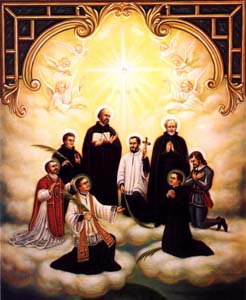
The Canadian Martyrs, also known as the North American Martyrs, were eight Jesuit missionaries from Sainte-Marie among the Hurons. They were ritually tortured and killed on various dates in the mid-17th century in Canada, in what is now southern Ontario, and in upstate New York, during the warfare between the Iroquioan tribes the Mohawk and the Huron. They have subsequently been canonized and venerated as martyrs by the Catholic Church.

The Missionary Oblates of Mary Immaculate (OMI) is a missionary religious congregation in the Catholic Church. It was founded on January 25, 1816, by Eugène de Mazenod, a French priest later recognized as a Catholic saint. The congregation was given recognition by Pope Leo XII on February 17, 1826. As of January 2020, the congregation was composed of 3,631 priests and lay brothers usually living in community. Their traditional salutation is Laudetur Iesus Christus, to which the response is Et Maria Immaculata. Members use the post-nominal letters, "OMI".

Ville-Marie is a town on Lake Temiscaming in western Quebec, Canada. It is the largest city and seat of the Témiscamingue Regional County Municipality. As one of the oldest towns in the Abitibi-Témiscamingue region, it is considered the cradle of north-western Quebec and nicknamed "Pearl of Témiscamingue".

Falher is a town in the Peace Country area of Alberta, Canada. It is located in the Municipal District of Smoky River No. 130, along Highway 49. Falher is one of the earliest agricultural communities in the Peace River Country, and still acts as the commercial center of the surrounding Smoky River Region, with which it shares much of its history. Falher is notable for its sizable francophone population, having the highest percentage of French speakers of any municipality in Western Canada, with 52% able to speak the language as of 2021.
The Oblates of St. Francis de Sales are a congregation of Catholic priests and brothers who follow the teachings of Francis de Sales and Jane Frances de Chantal. The community was founded in Troyes in 1875 by Louis Brisson and are affiliated with the Oblate Sisters of St. Francis de Sales.

The Mission district is an inner city neighbourhood of Calgary, Alberta, Canada, that originated as Notre Dame de la Paix, a Catholic mission and was for a time the incorporated Village of Rouleauville. Mission is bordered by 4th Street SW with restaurants and shops, and it hosts the Lilac Festival in June.

The Catholic Church in Myanmar is part of the worldwide Catholic Church, under the spiritual leadership of the Pope in Rome. In 2020, there were approximately 700,000 Catholics in Burma - approximately 1.29% of the total population.
The Roman Catholic Archdiocese of Keewatin–Le Pas is a Roman Catholic archdiocese that includes parts of the Provinces of Manitoba, Saskatchewan, and Ontario and has the suffragan diocese of Churchill-Baie d'Hudson. The current archbishop is Murray Chatlain.

Lebret is a village in the Canadian province of Saskatchewan within the Rural Municipality of North Qu'Appelle No. 187 and Census Division No. 6. The village is situated on Mission Lake of the Fishing Lakes in the Qu'Appelle Valley. Lebret is located along Highway 56, about 70 km (43 mi) northeast of the City of Regina. The village was named after "the parish priest, Father Louis Lebret, who became the first postmaster of the community and, although he only held the position for a little more than six months, the office was named Lebret and the name became that of the community."
Lac Ste. Anne is a large lake in central Alberta, Canada. It is in Lac Ste. Anne County, along Highway 43, 75 km west of Edmonton.
The Methodist Mission was the Methodist Episcopal Church's 19th-century conversion efforts in the Pacific Northwest. Local Indigenous cultures were introduced to western culture and Christianity. Superintendent Jason Lee was the principal leader for almost a decade. It was a political and religious effort. Two years after the mission began, the church's Board of Foreign Missions described its intent to reclaim "these wandering savages, who are in a very degraded state, to the blessings of Christianity and civilized life." Alongside the missions founded in the region were several secular operations opened. These were maintained to allow for material independence from the Hudson's Bay Company (HBC), then the preeminent economic entity in the region among European descendants.
Jean-Fleury Baudrand, O.M.I., was a French Roman Catholic priest and missionary who served in North America, where he died.

Île-à-la-Crosse is a northern village in Division No. 18, northwestern Saskatchewan, and was the site of historic trading posts first established in 1778. Île-à-la-Crosse is the second oldest community in Saskatchewan, Canada, following establishment of the Red River Colony in 1811. It sits at the end of a 20 km (12 mi) long peninsula on the western shore of Lac Île-à-la-Crosse, and is linked with Peter Pond Lake and Churchill Lake through a series of interconnected lakes, rivers, and portage routes.

Pella is an oasis in Namakwa (Bushmanland) in the Northern Cape province of South Africa. Earlier known as Cammas Fonteyn, the spring was used by a nearby stronghold of San people. In 1776 a South African Dutch farmer called Coenraad Feijt settled there and lived in harmony with the San despite their fondness for raiding the cattle of the Dutch farmers in the Hantam. A nearby farm called Aggeneys later became the site of the modern mining town of that name.

Georges-Antoine Belcourt, also George Antoine Bellecourt, was a French Canadian Roman Catholic diocesan priest and missionary. Born in Baie-du-Febvre, Quebec, Belcourt was ordained in 1827. He established missions in areas of Quebec and Manitoba. On the frontier, he became involved in a political dispute between the local First Nations population and the Hudson's Bay Company, the monopoly fur trading company.

Father Con Scollen OMI. was an Irish Catholic, Missionary priest who lived among and evangelized the Blackfoot, Cree and Métis peoples on the Canadian Prairies and in northern Montana in the United States. He also ministered to the Ktunaxa people (Kootenay) on their annual visits to Fort Macleod, from British Columbia. Later he worked among the indigenous peoples in modern-day North Dakota and Wyoming, then Nebraska, Kansas, Illinois and Ohio.

Jean-Charles-Jean-Baptiste-Félix Pandosy, commonly known as Father Pandosy, was a French Catholic priest who was the first settler in the Kelowna area in British Columbia. He set up a church and a school and attracted many settlers to the area. He founded the Okanagan Mission which was the first permanent white settlement in the British Columbia Interior aside from the forts for the Hudson's Bay Company and the gold rush boomtowns of the Fraser Canyon.

The Malahang Mission Station is a Lutheran filial station situated in Malahang, Morobe Province in Papua New Guinea now under the auspices of the Evangelical Lutheran Church of Papua New Guinea. The Mission station is located on Busu Road, Malahang opposite the Malahang Industrial Area.

Mount St Mary's Church or the Church of the Immaculate Virgin Mary is a Grade II* listed building and a redundant Roman Catholic church in Leeds, West Yorkshire, England. It was founded in 1851 and designed by Joseph Hansom, with extensions by Edward Pugin. It is next to Mount St Mary's Catholic High School, Leeds.

The Martyrs of Laos are seventeen Catholic priests and professed religious as well as one lay young man venerated as martyrs killed in Laos between 1954 and 1970 of the First and Second Indochina Wars during a period of anti-religious sentiment under the Pathet Lao Theravada Buddhist-communist political movement.

















